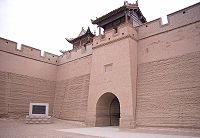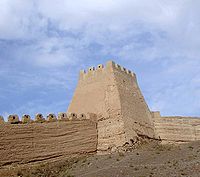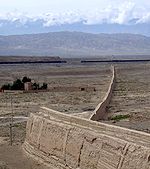
Jiayuguan Pass
Encyclopedia

Great Wall of China
The Great Wall of China is a series of stone and earthen fortifications in northern China, built originally to protect the northern borders of the Chinese Empire against intrusions by various nomadic groups...
, near the city of Jiayuguan in Gansu
Gansu
' is a province located in the northwest of the People's Republic of China.It lies between the Tibetan and Huangtu plateaus, and borders Mongolia, Inner Mongolia, and Ningxia to the north, Xinjiang and Qinghai to the west, Sichuan to the south, and Shaanxi to the east...
province. It has also been called "Jiayuguan Pass"; however, this form is redundant since "guan" means "pass" in Chinese. Along with Juyongguan
Juyongguan
Juyongguan or Juyong Pass is located in an -long valley named "Guangou" which is inside Changping County more than from Beijing City. It is one of the three greatest passes of the Great Wall of China. The other two passes are Jiayuguan and Shanhaiguan....
and Shanhaiguan, it is one of the main passes of the Great Wall.
Location
The pass is located at the narrowest point of the western section of the Hexi CorridorHexi Corridor
Hexi Corridor or Gansu Corridor refers to the historical route in Gansu province of China. As part of the Northern Silk Road running northwest from the bank of the Yellow River, it was the most important route from North China to the Tarim Basin and Central Asia for traders and the military. The...
, 6 kilometers southwest of the city of Jiayuguan in Gansu
Gansu
' is a province located in the northwest of the People's Republic of China.It lies between the Tibetan and Huangtu plateaus, and borders Mongolia, Inner Mongolia, and Ningxia to the north, Xinjiang and Qinghai to the west, Sichuan to the south, and Shaanxi to the east...
. The structure lies between two hills, one of which is called Jiayuguan Hill. It was built near an oasis
Oasis
In geography, an oasis or cienega is an isolated area of vegetation in a desert, typically surrounding a spring or similar water source...
that was then on the extreme western edge of China.
Description


There are two gates: one on the east side of the pass, and the other on the west side. On each gate there is a building. An inscription of "Jiayuguan" in Chinese is written on a tablet at the building at the west gate. The south and north sides of the pass are connected to the Great Wall. There is a turret
Turret
In architecture, a turret is a small tower that projects vertically from the wall of a building such as a medieval castle. Turrets were used to provide a projecting defensive position allowing covering fire to the adjacent wall in the days of military fortification...
on each corner of the pass. On the north side, inside the two gates, there are wide roads leading to the top of the pass.
Jiayuguan consists of three defense lines: an inner city, an outer city and a moat.
Legend and History

Legend
A legend is a narrative of human actions that are perceived both by teller and listeners to take place within human history and to possess certain qualities that give the tale verisimilitude...
recounts the meticulous planning involved in the construction of the pass. According to legend
Legend
A legend is a narrative of human actions that are perceived both by teller and listeners to take place within human history and to possess certain qualities that give the tale verisimilitude...
, when Jiayuguan was being planned, the official in charge asked the designer to estimate the exact number of bricks required and the designer gave him a number. The official questioned his judgment, asking him if that would be enough, so the designer added one brick. When Jiayuguan was finished, there was one brick left over, which was placed loose on one of the gates where it remains today.
The structure was built during the early Ming dynasty
Ming Dynasty
The Ming Dynasty, also Empire of the Great Ming, was the ruling dynasty of China from 1368 to 1644, following the collapse of the Mongol-led Yuan Dynasty. The Ming, "one of the greatest eras of orderly government and social stability in human history", was the last dynasty in China ruled by ethnic...
, sometime around the year 1372. The fortress there was greatly strengthened due to fear of an invasion by Timur
Timur
Timur , historically known as Tamerlane in English , was a 14th-century conqueror of West, South and Central Asia, and the founder of the Timurid dynasty in Central Asia, and great-great-grandfather of Babur, the founder of the Mughal Dynasty, which survived as the Mughal Empire in India until...
, but Timur died of old age while leading an army toward China.
Significance

Shanhaiguan District
Shanhaiguan District is a district of the city of Qinhuangdao, Hebei province, People's Republic of China, named after the pass of the Great Wall within the district, Shanhai Pass...
at the east end of the Great Wall near Qinhuangdao
Qinhuangdao
Qinhuangdao is a port city in northeastern Hebei province of North China. It is about 300 km east of Beijing, on the Bohai Sea, the innermost gulf of the Yellow Sea....
, Hebei
Hebei
' is a province of the People's Republic of China in the North China region. Its one-character abbreviation is "" , named after Ji Province, a Han Dynasty province that included what is now southern Hebei...
.
The pass was a key waypoint of the ancient Silk Road
Silk Road
The Silk Road or Silk Route refers to a historical network of interlinking trade routes across the Afro-Eurasian landmass that connected East, South, and Western Asia with the Mediterranean and European world, as well as parts of North and East Africa...
.
Jiayuguan has a somewhat fearsome reputation because Chinese people who were banished were ordered to leave through Jiayuguan for the west, never to return.
Around Jiayuguan there are few historic sites such as elsewhere in Gansu province and on the Silk Road. Many frescos were found in the areas around Jiayuguan.

